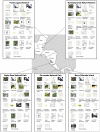Traditions in spider monkeys are biased towards the social domain
- PMID: 21373196
- PMCID: PMC3044143
- DOI: 10.1371/journal.pone.0016863
Traditions in spider monkeys are biased towards the social domain
Abstract
Cross-site comparison studies of behavioral variation can provide evidence for traditions in wild species once ecological and genetic factors are excluded as causes for cross-site differences. These studies ensure behavior variants are considered within the context of a species' ecology and evolutionary adaptations. We examined wide-scale geographic variation in the behavior of spider monkeys (Ateles geoffroyi) across five long-term field sites in Central America using a well established ethnographic cross-site survey method. Spider monkeys possess a relatively rare social system with a high degree of fission-fusion dynamics, also typical of chimpanzees (Pan troglodytes) and humans (Homo sapiens). From the initial 62 behaviors surveyed 65% failed to meet the necessary criteria for traditions. The remaining 22 behaviors showed cross-site variation in occurrence ranging from absent through to customary, representing to our knowledge, the first documented cases of traditions in this taxon and only the second case of multiple traditions in a New World monkey species. Of the 22 behavioral variants recorded across all sites, on average 57% occurred in the social domain, 19% in food-related domains and 24% in other domains. This social bias contrasts with the food-related bias reported in great ape cross-site comparison studies and has implications for the evolution of human culture. No pattern of geographical radiation was found in relation to distance across sites. Our findings promote A. geoffroyi as a model species to investigate traditions with field and captive based experiments and emphasize the importance of the social domain for the study of animal traditions.
Conflict of interest statement
Figures




Similar articles
-
Universal behaviors as candidate traditions in wild spider monkeys.PLoS One. 2011;6(9):e24400. doi: 10.1371/journal.pone.0024400. Epub 2011 Sep 19. PLoS One. 2011. PMID: 21949715 Free PMC article.
-
Behavioral and physiological responses to fruit availability of spider monkeys ranging in a small forest fragment.Am J Primatol. 2014 Nov;76(11):1049-61. doi: 10.1002/ajp.22292. Epub 2014 May 12. Am J Primatol. 2014. PMID: 24820229 Free PMC article.
-
How Survey Design Affects Monkey Counts: A Case Study on Individually Recognized Spider Monkeys (Ateles geoffroyi).Folia Primatol (Basel). 2017;88(5):409-420. doi: 10.1159/000481796. Epub 2017 Dec 1. Folia Primatol (Basel). 2017. PMID: 29190614
-
Factors underlying party size differences between chimpanzees and bonobos: a review and hypotheses for future study.Primates. 2009 Jul;50(3):197-209. doi: 10.1007/s10329-009-0141-6. Epub 2009 Apr 8. Primates. 2009. PMID: 19353234 Review.
-
Diet of spider monkeys (Ateles geoffroyi) in Mesoamerica: current knowledge and future directions.Am J Primatol. 2009 Jan;71(1):8-20. doi: 10.1002/ajp.20625. Am J Primatol. 2009. PMID: 18942095 Review.
Cited by
-
Call cultures in orang-utans?PLoS One. 2012;7(5):e36180. doi: 10.1371/journal.pone.0036180. Epub 2012 May 7. PLoS One. 2012. PMID: 22586464 Free PMC article.
-
Organized to learn: the influence of social structure on social learning opportunities in a group.iScience. 2021 Feb 3;24(2):102117. doi: 10.1016/j.isci.2021.102117. eCollection 2021 Feb 19. iScience. 2021. PMID: 33659880 Free PMC article. Review.
-
Animal cultures: how we've only seen the tip of the iceberg.Evol Hum Sci. 2019 May 23;1:e2. doi: 10.1017/ehs.2019.1. eCollection 2019. Evol Hum Sci. 2019. PMID: 37588402 Free PMC article. Review.
-
Integrating culture into primate conservation.Philos Trans R Soc Lond B Biol Sci. 2025 May;380(1925):20240135. doi: 10.1098/rstb.2024.0135. Epub 2025 May 1. Philos Trans R Soc Lond B Biol Sci. 2025. PMID: 40308144 Free PMC article. Review.
-
The development of social attention in orangutans: Comparing peering behavior in wild and zoo-housed individuals.iScience. 2024 Dec 6;28(1):111542. doi: 10.1016/j.isci.2024.111542. eCollection 2025 Jan 17. iScience. 2024. PMID: 39811666 Free PMC article.
References
-
- Fragaszy DM, Perry S. Towards a biology of traditions. In: Fragaszy DM, Perry S, editors. The biology of traditions: Models and evidence. Cambridge: Cambridge University Press; 2003. pp. 1–32.
-
- McGrew WC. Culture in nonhuman primates? Annual Review of Anthropology. 1998;27:301–328.
-
- Whiten A, Goodall J, McGrew WC, Nishida T, Reynolds V, et al. Cultures in chimpanzees. Nature. 1999;399:682–685. - PubMed
-
- Rendell L, Whitehead H. Culture in whales and dolphins. Behavioral and Brain Sciences. 2001;24:309–382. - PubMed
-
- Perry S, Baker M, Fedigan L, Gros-Louis J, Jack K, et al. Social conventions in wild White-faced Capuchin monkeys: Evidence for traditions in a neotropical primate. Current Anthropology. 2003;44:241–268.
Publication types
MeSH terms
LinkOut - more resources
Full Text Sources
Research Materials
Miscellaneous

